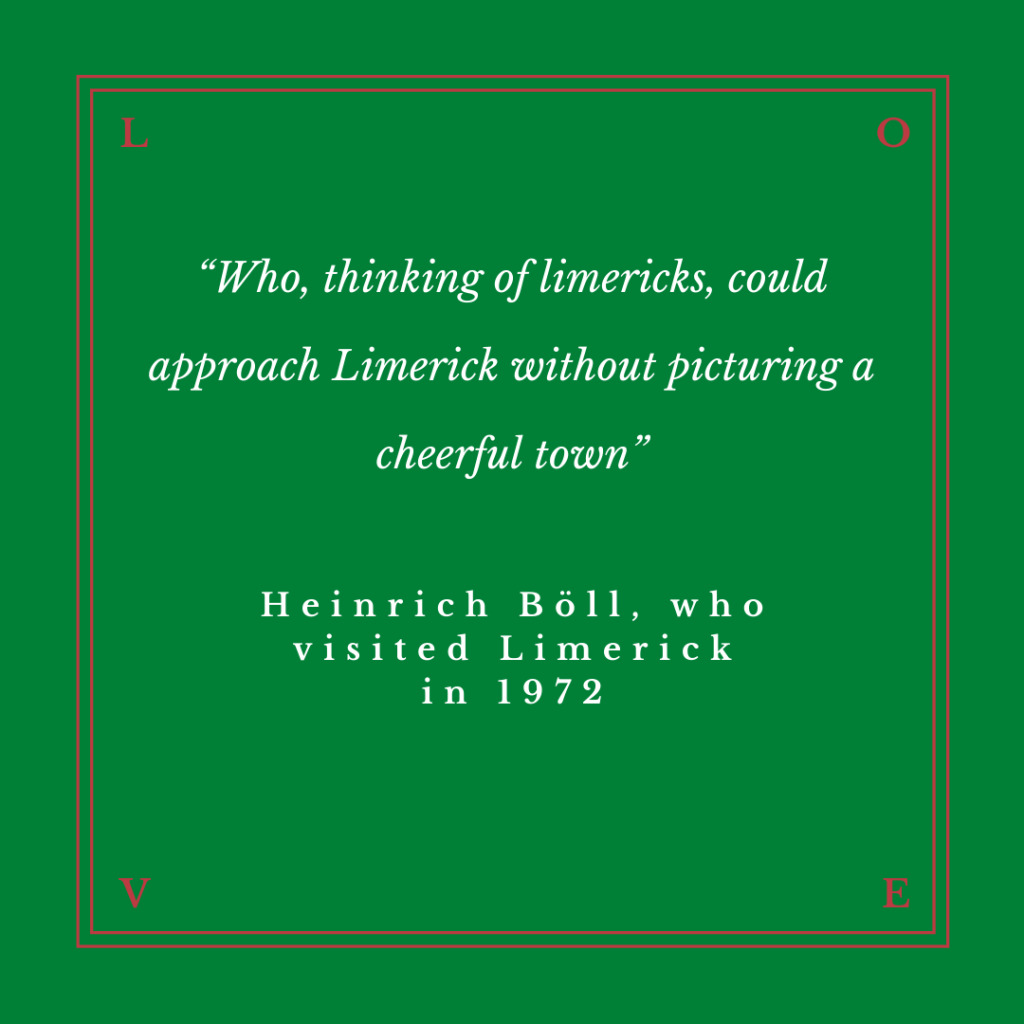
“Who, thinking of limericks, could approach Limerick without picturing a cheerful town”
Heinrich Böll, who visited Limerick in 1972
Heinrich Theodor Böll ( 21 December 1917 – 16 July 1985) was one of Germany’s foremost post–World War II writers. Böll was awarded the Georg Büchner Prize in 1967 and the Nobel Prize for Literature in 1972.
For many Limerick, Limericks and poetry are difficult to separate. For some, the Limerick may have been their introduction to poetry, for others they never moved beyond the fun of the Limerick to enjoy the breadth of opportunity offered by poetry.
It is widely thought that Edward Lear invented the Limerick, although this is probably incorrect.
The Limerick as a form was popularised by Edward Lear in his first Book of Nonsense (1846) and a later work, More Nonsense, Pictures, Rhymes, Botany, etc. (1872). Lear wrote 212 Limericks, mostly considered nonsense literature. The humour is not in the punch line ending but rather in the tension between meaning and the lack of meaning.
In one of his typical Limericks, Lear wrote:
There was a Young Person of Smyrna
Whose grandmother threatened to burn her.
But she seized on the cat,
and said ‘Granny, burn that!
You incongruous old woman of Smyrna!’
Whether he invented it or not, Lear certainly made the Limerick popular. The Oxford English Dictionary first defined the word Limerick in 1892, four years after Lear’s death. But as OE Parrott makes clear in the opening pages of The Penguin Book of Limericks:
The Limerick’s birth is unclear:
Its genesis owed much to Lear.
It started as clean,
But soon went obscene.
And this split haunts its later career.
But in Limerick, it is said the five-line verse probably originated from the Limerick-makers of Croom, known as the Maigue poets, who worked in the 18th century. They were school-teachers, priests and self-styled persons of letters, living within 30 km of Croom. Their gatherings and revels in pubs and inns were said to resemble the ancient Irish bardic schools, conducted in Greek, Latin and Irish.
One of the Maigue’s first-known Limerick-writers was a publican, John O’Toumy, who was born near Croom in 1706. Of his own business practices, he bemoaned:
I sell the best brandy and sherry,
To make my good customers merry.
But at times their finances
Run short as it chances,
And then I feel very sad, very.
To this another Maigue poet, Andrew McCrath, quickly retorted:
O’Toumy! You boast yourself handy
At selling good ale and fine brandy,
But the fact is your liquor
Makes everyone sicker,
I tell you that, I, your friend, Andy.
Ronald Knox caricatured the philosophy and theology of the I8th century Irish bishop George Berkeley in a pair of Limericks:
There was a young man who said, ‘God
Must think it exceedingly odd
If he finds that this tree
Continues to be
When there’s no-one about in the Quad.’
And the reply, according to Knox was:
Dear Sir:
Your astonishment’s odd:
I am always about in the Quad.
And that’s why the tree
Will continue to be,
Sincerely observed by, Yours faithfully, GOD.
The poet WH Auden, whose literary corpus is marked by thoughtfulness and solemnity, seemed to find release in the humour of the Limerick:
T.S. Eliot is quite at a loss
When clubwomen bustle across
At literary teas,
Crying: ‘What, if you please,
Did you mean by The Mill on the Floss?’
